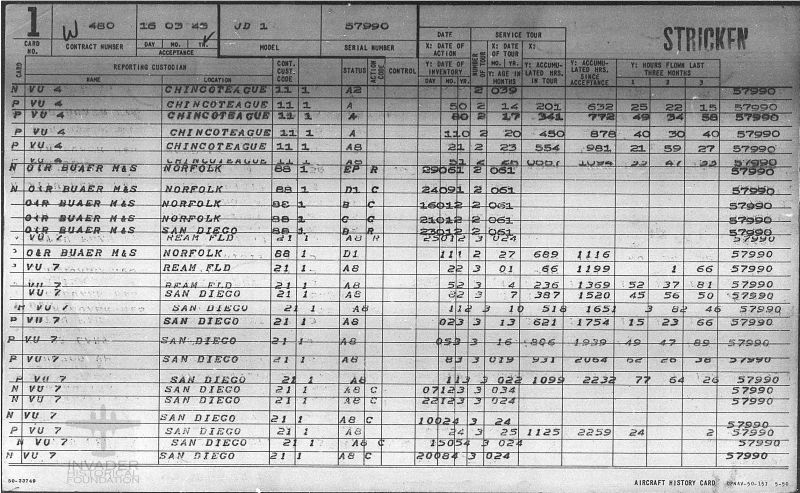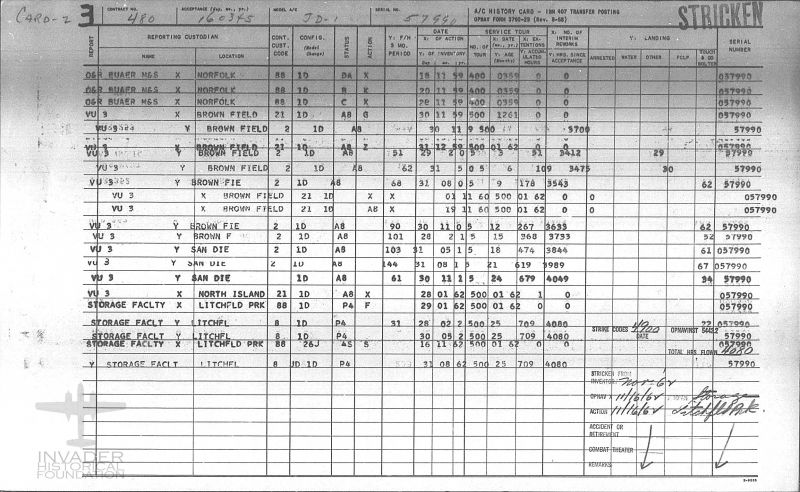Reading the Inventory Cards
This page will provide guidance on how to read the Inventory Cards and reports.
USAF Individual Aircraft Record Cards (IARC) (1944-1950)
Format
Codes
USAF Individual Aircraft Record Cards (IARC) (1950-1960)
Format
Codes
USAF Aerospace Vehicle Reports (AVR) (1960-)
Format
Codes
Format
The US Navy Used three different types of Aircraft History Cards for tracking their JD-1 Invaders. The first card is officially identified as type NAVAER-1925 (9-44). This card was in use from 1944 until 1950.
In 1950, the Navy switched to the second card, OPNAV-50-157 (5-50). This card came into use in May 1950.
In 1958 the Navy switched again to the third card, OPNAV FORM 3760-29 (8-58).
Let's look at each in a little more detail.
NAVAER-1925
The image below is an example of the NAVAER-1925 card. This card is very simple to read. There is a fat line with three boxes and under that is a skinny line with boxes that say: J F M A M J J A S O N D. The first thing to take note of is the Date Accepted value at the top of the card. In this case, 16 Mar 1945. That means that the first line on this card represents 1945. Next, we look at the first UNIT listed there. In this case it's VJ-4 (which was later re-designated VU-4). We can see that M A M J J are checked. These letter represent the months of the year. so from Mar 1945 until July 1945 this plane was with the Utility Squadron 4.
On the next line down there should be a check mark on the A for August while the plane was at Litchfield, but we can fill in the gaps here because we can see that it arrived in September 1945 to O&R Norfolk. So from July to Sep 1945 the plane was in storage.
Then the plane spent 10 months at O&R Norfolk; Sep, Oct, Nov, Dec 1945, then on the next line 1946 starts and it was there from Jan through Jun.
The card continues on in this fashion. It is pretty easy to track where the plane was. However, this card is not very detailed and is prone to some errors, as we observed with Aug 1945. The cards are also usually not very detailed and don't give exact dates very often. Consistently, the periods from the fall of 1948 until 1950 are very spotty and not well reported on these cards. as one example, let's look at 1948 on the card below. The last unit that was actually reported was the Operational Pool at Norfolk Naval Air Station. The plane was there from Oct 1947 until at least Aug 1948. Now, the column to the right and below, it says "O/H 3-3-49" scrawled in the margin. O/H is shorthand for Overhaul. So the plane was being overhauled on 3 Mar 1949. This tells us that at some point the plane must have been transferred from the Operational Pool at Norfolk NAS to the Overhaul & Repair Facility at Norfolk because the pool doesn't do overhauls. But, when those dates are, specifically, we have no idea. It could have transferred to O&R Norfolk in Sep 1948 or any time until Feb 1949. The planes almost always sit for some period of time before being worked on, so it didn't arrive in Mar 1949.
While the card is fairly easy to read, it is not very detailed and provides no other information aside from basic locations or assignments. There's no data on status, flight hours, or anything of that sort listed. And the 1949 time period has, so far, been very spotty on every card I have seen.

OPNAV-50-157
I'll go on record right now and say that there are some fields on this type of card that I don't understand. For example, the very first column that says "Card" and lists N or P. I have no idea what that means. But I can read enough of this card to make sense of where the plane was and what it was doing.
The Name and Location fields are pretty self explanatory. This is what unit or command had the plane and where they were located.
The next two columns I don't understand. I have no idea what Cont. Cust. Code means.
The Status Codes I do know. I found another report that breaks them all down and I have them enumerated in the section below called "Codes", but I do not know what the Action code means.
The date codes can be a little tricky at first, especially since the date data tends to blend in with the "Number of Tour" data beside it. The date is always listed as Day, Month, Year....unless the date is omitted, in which case it's just month and year. In most cases the "Year" value is just the last digit of the year. They did use two digit years, sometimes, seemingly at random, but not until at least the mid-1950s.
The Number of Tour seems to be a "Tour of duty" that appears to relate loosely to Time Between Overhauls.
The Age in Months is how many months the plane spent in each tour. Note that in this column the Overhaul & Repair Facilities report it differently instead typing out the two-digit month and single digit year that the plane arrived at the facility. That why on the example card below the the number jumps from 23 to 061 and then back to 24 again. The 061 isn't the number of months, it's actually Jun 1951.
Accumulated Hours is pretty self-explanatory. This is the number of hours the airframe has accumulated sine it started it's service life with the Navy. However, the values for the hours flown for the last 3 months should be taken with a grain of salt. In some cases, as in the top of the card, the reporting lines are 3 months apart and it seems to match up well. However, in a couple of cases I have seen the next reporting line was only 1 or 2 months later, but it listed 3 different hours values, which doesn't make sense.
The last column is the aircraft's Bureau Number (BuNo).
One note with this type of card is that sometimes the the line entries are recorded out of order for some reason. As an example, in the card below there are several entries for O&R BAUER M&S NORFOLK that start on 29 Jun 1951 and end on Nov 1951. But, the next to last line of this block is "VU-7 REAM FLD", 25 Jan 1952. That line and the line below it should be flipped as they are out of order chronologically.
OPNAV 3760-29
On the surface, this card is very similar to it's predecessor. It starts with a report field, which doesn't appear to be used.
Name and Location is the same as the OPNAV-50-157 cards. As is the mysterious Cont. Cust. Code field.
The Configuration Field is new. This field tells us what version of plane we are looking at. In this example it says "1D", which would be the JD-1D, drone controller aircraft.
The status and action codes are the same as the previous cards.
The next column is a modification from the previous card. This column shows total Flight Hours (F/H) over a 3 month period, so this is a combination of the other 3 month fields combined into a single value.
The date fields are usually two digit day, two digit month, two digit year, although sometimes a single digit month or year is used.
The service tour information is more complex on this card and I have not worked out all of the details.
The next column is "Hours Since Acceptance". This is how many total flight hours the airframe has.
There is an entire section that tracks landing information, which is unique to this card, but self-explanatory.
The card ends with the serial (Bureau) number.
Codes
The older card, NAVAER-1925, does not use any codes at all. So the entirety of this section will be applicable only to the OPNAV-50-157 and OPNAV 3760-29 cards. The status codes are the same for both cards.

